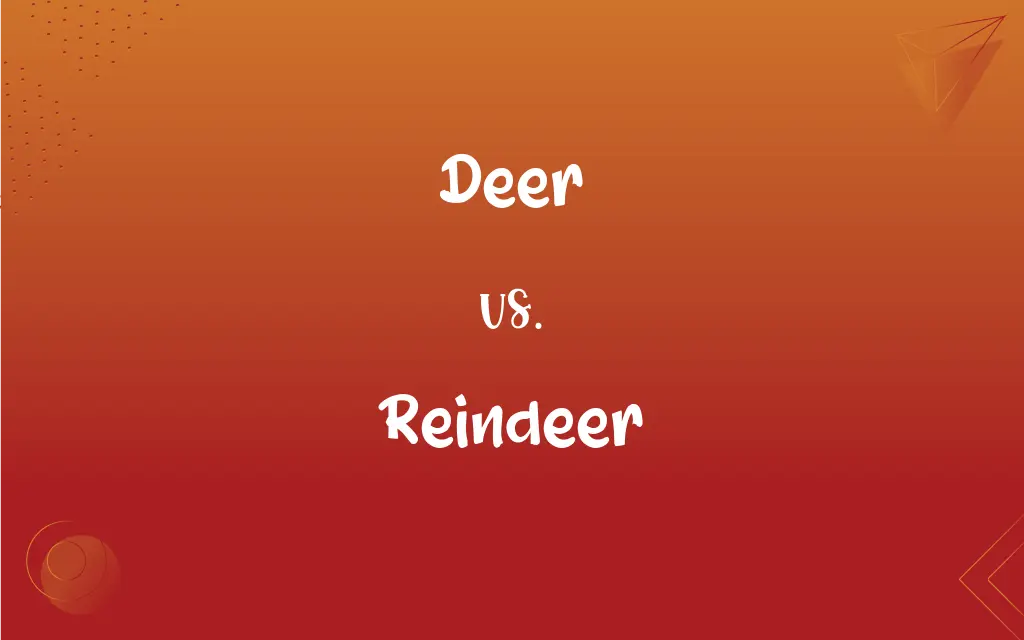Deer vs. Reindeer: What's the Difference?
Edited by Janet White || By Harlon Moss || Updated on July 4, 2024
Deer refers to a family of herbivorous mammals with species like whitetails, while reindeer, a deer species, is notable for its adaptation to cold climates and historical sled-pulling.

Key Differences
The term "deer" encompasses a wide variety of species within the Cervidae family, including animals widely recognized for their graceful builds and impressive antlers. Deer inhabit various environments, from the dense forests of North America to the open plains of Africa. They can be identified by their slender bodies, long legs, and typically, a subtle, often speckled coat. In contrast, reindeer hold specific characteristics that distinguish them clearly within the deer family.
Reindeer, known as Caribou in North America, are well-adapted to frigid environments, displaying traits significantly attuned to survival in harsh, subarctic climates. Unlike other deer species, reindeer possess a dense, water-resistant coat, enabling them to survive in icy, wet conditions. Their large, sweeping antlers are renowned, and unlike many deer species, both male and female reindeer develop these striking features, amplifying their distinctive appearance within the deer family.
Deer species exhibit varied sizes, colors, and habitat preferences, with species like the diminutive Key deer or the larger Red deer showcasing the vast diversity within the family. Most deer species are not adapted to life in extreme cold and do not display the thick, insulating fur or large, flat hooves characteristic of reindeer. The diversity among deer species thus opens a rich tapestry of adaptive traits and ecological niches, revealing fascinating variations within the family.
Conversely, reindeer not only exhibit physical adaptations to the cold but also partake in remarkable migratory behaviors, traveling extensive distances across tundra and taiga to access seasonal resources. Furthermore, human cultures, particularly within the Arctic Circle, have historically utilized reindeer for various purposes, including using them to pull sleds, which is not a common practice with other deer species. This intersection with human society enriches the story of reindeer, intertwining ecology and culture.
While both deer and reindeer share a familial bond and thus bear certain anatomical similarities, their respective adaptive strategies and the environments they inhabit create a stark contrast between generalized deer characteristics and the specialized traits of reindeer. By exploring these differences, one traverses the globe, from the general, widespread distribution of deer to the cold, specifically adapted world of the reindeer, illuminating the adaptive beauty of nature's designs.
ADVERTISEMENT
Comparison Chart
Habitat
Various, including forests, grasslands, and swamps
Tundra, subarctic and arctic regions
Physical Adaptations
Generally slender with various fur patterns and colorations
Thick, dense fur for insulation against cold
Antlers
Primarily males develop antlers
Both males and females grow antlers
Human Interaction
Often hunted, occasionally found in zoos
Historically used for pulling sleds and herded
Size and Build
Diverse sizes and builds across species
Sturdy build with a particularly dense fur coat
ADVERTISEMENT
Deer and Reindeer Definitions
Deer
Herbivorous animals known for their gentle demeanor and wide, innocent eyes.
The child was delighted at the sight of a deer in the backyard.
Reindeer
The only deer species where both males and females commonly grow antlers.
Observers often marvel at the intricate antlers of both male and female reindeer.
Deer
Creatures often symbolizing grace, gentleness, and wilderness in various cultures.
A beautiful mural of a deer adorned the rustic cabin’s wall.
Reindeer
A vital resource in certain human cultures, providing transportation, meat, and hides.
Indigenous populations have utilized reindeer for their sustainability and utility in harsh climates.
Deer
A family of hoofed, usually antlered mammals found worldwide, excluding Antarctica.
The deer gracefully leaped through the quiet forest.
Reindeer
Recognizable for their large, broad hooves that assist in traversing snowy landscapes.
The reindeer’s uniquely adapted hooves provide stability on the snow and icy terrains.
Deer
Animals frequently found in various ecosystems, including forests, savannas, and grasslands.
The naturalist spent years studying the behavior of deer in different habitats.
Reindeer
Known as caribou in North America, recognized for their impressive migratory journeys.
Vast herds of reindeer migrate across the tundra, showcasing a breathtaking natural spectacle.
Deer
Mammals with species showcasing a variety of antler shapes and sizes.
The majestic deer, with its impressive antlers, stood silhouetted against the sunset.
Reindeer
A species of deer adapted to arctic and subarctic climates, known for its dense, insulating fur.
The reindeer effortlessly trotted across the icy tundra.
Deer
Any of various hoofed ruminant mammals of the family Cervidae, characteristically having deciduous antlers borne chiefly by the males. The deer family includes the white-tailed deer, elk, moose, and caribou.
Reindeer
A large deer (Rangifer tarandus) of the Arctic tundra and northern boreal forests, having large hooves and long branched antlers, and widely domesticated in Eurasia. Subspecies native to North America and Greenland are usually called caribou.
Reindeer
(plural: reindeer) Any Arctic and subarctic-dwelling deer of the species Rangifer tarandus, with a number of subspecies.
Reindeer
Any species, subspecies, ecotype, or other scientific grouping of such animals.
Reindeer
To herd or farm reindeer
Reindeer
Any ruminant of the genus Rangifer, of the Deer family, found in the colder parts of both the Eastern and Western hemispheres, and having long irregularly branched antlers, with the brow tines palmate.
Reindeer
Arctic deer with large antlers in both sexes; called reindeer in Eurasia and caribou in North America
FAQs
Do all deer species have antlers?
Most male deer have antlers; however, female reindeer also commonly have them, which is unusual among deer.
Are reindeer and caribou the same?
Yes, they are the same species, but the name "reindeer" is generally used in Europe and Asia, while "caribou" is used in North America.
What are young deer and reindeer called?
Young deer and reindeer are commonly referred to as fawns or calves.
Do both deer and reindeer have good hearing?
Yes, both species have acute hearing which helps them detect predators.
Can deer and reindeer swim?
Yes, both deer and reindeer are capable swimmers.
Do deer have a mating season?
Yes, deer have a specific mating season, often occurring in the fall.
How fast can deer and reindeer run?
Deer can run up to 60 km/h (37 mph), while reindeer speeds are slightly lower, around 50-60 km/h.
Are there deer species that live in the desert?
Yes, for example, the mule deer can be found in the deserts of North America.
Is it true that reindeer noses are specially adapted to cold climates?
Yes, reindeer have specialized nasal passages that warm the air before it reaches the lungs.
Why do reindeer have a thicker coat than other deer species?
The thick coat provides insulation, vital for survival in the harsh, cold environments they inhabit.
Are deer and reindeer ruminants?
Yes, they both have a four-chambered stomach and engage in cud-chewing.
Are reindeer domesticated?
Reindeer have been semi-domesticated in some regions, used for transportation, milk, and other resources.
How do reindeer deal with constant daylight or darkness in the Arctic?
Reindeer have adapted to these conditions and can regulate their biological clocks without relying on daylight.
Are deer found worldwide?
Deer are found on all continents except Antarctica, with various species adapted to different environments.
Do deer and reindeer have the same diet?
Both generally have herbivorous diets but the specifics can vary greatly due to the availability of vegetation in their respective habitats.
Do all deer migrate like reindeer?
No, while some deer species migrate, reindeer are especially known for their long-distance migratory behaviors.
Do both deer and reindeer serve as prey for predators?
Yes, they are prey for various predators, including wolves and bears.
Can reindeer really pull sleds?
Yes, reindeer have been used to pull sleds by various Arctic peoples for centuries.
Are reindeer a type of deer?
Yes, reindeer are a species within the deer family, Cervidae.
Are white-tailed deer the most common deer in the Americas?
Yes, white-tailed deer are widespread and common across much of North America.
About Author
Written by
Harlon MossHarlon is a seasoned quality moderator and accomplished content writer for Difference Wiki. An alumnus of the prestigious University of California, he earned his degree in Computer Science. Leveraging his academic background, Harlon brings a meticulous and informed perspective to his work, ensuring content accuracy and excellence.
Edited by
Janet WhiteJanet White has been an esteemed writer and blogger for Difference Wiki. Holding a Master's degree in Science and Medical Journalism from the prestigious Boston University, she has consistently demonstrated her expertise and passion for her field. When she's not immersed in her work, Janet relishes her time exercising, delving into a good book, and cherishing moments with friends and family.
































































